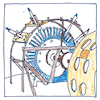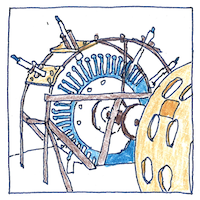Reginald Fessenden
telecommunication

|
AM broadcasting
Reginald Fessenden’s first AM transmission in December 1900 used a carbon microphone in series with a rotary spark-gap transmitter producing ten thousand sparks per second, but the spark-gap transmitter was too noisy and too spread out over over the frequency band to carry clear voice transmissions, and the Branly or Marconi coherer was too crude to demodulate a voice frequency. So Fessenden began to work to improve both the transmitter and the receiver. He invented the process of heterodyning to modulate and demodulate an AM signal. He invented the hot wire barretter and various electrolytic detectors to rectify the received signal. He contracted with GE for the Alexanderson alternator to produce a high frequency radio carrier signal.
Wireless telephone
We had Morse-code telegraphy by radio and by telegraph, and telephone networks dependent on wires. People did not have radios in their homes or in their cars. There were no radio broadcasts. So people thought of AM radio as a wireless telephone, not as a broadcast to the masses.
Dental receptionist
Ethel Merman reported that Lucille Ball reported receiving radio broadcasts via temporary dental fillings in 1942, early in World War II. She was able to overhear a broadcast of an underground radio station from a Japanese spy and reported it at work to MGM security officials, resulting in the arrest of someone’s gardener. Was this a fabrication of a pair of comediennes or, in any case, is there a case for dental receptionists?



Services such as Twitter and Facebook, broadcasting to cell phones (wireless telephones), complete the circle that began with the development of radio as a broadcast media.
See also in The book of science:
Readings in wikipedia:
Other readings: